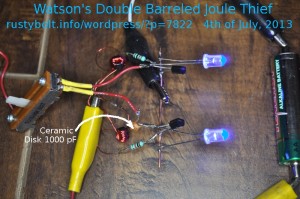I was thinking of Paul’s Joule Thiefs, which use a CdS photocell to shunt the base bias current to negative during the daytime, so the JT stops flashing and saves the battery.
But then I thought what would happen if I took two of these JTs, and put the photocell of the first one near the LED of the second one. Then put the photocell of the second one near the LED of the first one. The photocell of each is being influenced by the light of the LED of the other. Will this tend to synchronize the two so that they will both be on the same frequency? Or will the photocell’s response be so slow that they will not synchronize? Or will they try to synch up, but never quite synch, and instead interact with a beat frequency that is visible as a slow or fast change in brightness? This should be an interesting experiment.
One thing is likely to happen: the room light will probably interfere with the interaction. It may be necessary to keep the room dark to avoid this. Another thought occurred. There may be a critical point where the two JTs are stable, but very sensitive to any changes in the ambient light.
It may be possible to get them to also interact with small changes, so if someone waves their hand over them and causes a shadow, will it cause a disturbance that propagates from one to the other?
This looks like an experiment that could burn up a bit of ones time, but might have some interesting results.
A Different Interaction
 I built two very similar JTs on the same ground bus. Both positive leads were soldered together. The transistors were PN2222A, as were the 1k resistors. The LEDs were both blue. The coils used the same core, and with three strands of 30 AWG solid enameled wire about 9 inches long wound trifilar. One winding was separated for the feedback (base) winding, and the remaining two were soldered together for the primary (collector) winding. I wound one of the JTs with a few more turns, so one coil measured 590 uH, the other measured 690 uH. I thought this was better because the two would run at different frequencies.
I built two very similar JTs on the same ground bus. Both positive leads were soldered together. The transistors were PN2222A, as were the 1k resistors. The LEDs were both blue. The coils used the same core, and with three strands of 30 AWG solid enameled wire about 9 inches long wound trifilar. One winding was separated for the feedback (base) winding, and the remaining two were soldered together for the primary (collector) winding. I wound one of the JTs with a few more turns, so one coil measured 590 uH, the other measured 690 uH. I thought this was better because the two would run at different frequencies.
With 1.5V power connected, both blue LEDs lit up brightly. I measured one at 31 kHz, and the other at 36 kHz. I put the o’scope on one. I connected a 1 nF capacitor (to block DC) and a 10k pot in series, and then to the collectors of both transistors. As I varied the pot, I could see the pulses interfere, but I didn’t see any variation or ‘galloping’ in the brightness of the LEDs. This was what I was looking for: a visible pulsing if the LEDs, sort of like a candle flickering.
I disconnected the cap and pot and connected a red LED between the collectors. It lit up, a bit dim, and caused a drop in brightness of the blue LEDs. It looked to me as if the two JTs were trying to synchronize when I coupled them together. But the slippage was too fast to be visible as pulsating light. I’m going to have to think about reducing the difference in their frequencies. Perhaps I should add the CdS photocells and try to get coupling in the way I talked about at the beginning of this blog.
Update Jul 4 – I removed turns on the one with higher inductance so that it would be about the same as the other. I checked the two with the scope as I varied the resistor. At certain points, I saw the waveform gallop or blur, but this must be too fast to see because the LEDs looked like steady brightness.
I brought a neodymium magnet close to the core of one toroid, and it changed the waveform on the scope, but I didn’t see any change in the LED brightness, just steady light. They seem to be independent, must be because this is Independence Day! I’m still thinking about this, but for right now, I think I’ll do something else.